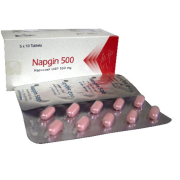Bpxen Tablet
Naproxen Sodium
500 mg
Bristol Pharmaceuticals Ltd.
Unit Price: ৳ 7.50 (30’s pack: ৳ 225.00)
Indications
Bpxen is indicated for the relief of sign and symptoms of-
- rheumatoid arthritis
- osteoarthritis
- ankylosing spondylitis
- juvenile arthritis
- tendonitis
- bursitis
- acute gout
It is also indicated for the management of primary dysmenorrhea & pain.
Pharmacology
As with other non-selective NSAIDs, naproxen exerts it’s clinical effects by blocking COX-1 and COX-2 enzymes leading to decreased prostaglandin synthesis. Although both enzymes contribute to prostaglandin production, they have unique functional differences. The COX-1 enzymes is constitutively active and can be found in normal tissues such as the stomach lining, while the COX-2 enzyme is inducible and produces prostaglandins that mediate pain, fever and inflammation. The COX-2 enzyme mediates the desired antipyretic, analgesic and anti-inflammatory properties offered by Naproxen, while undesired adverse effects such as gastrointestinal upset and renal toxicities are linked to the COX-1 enzyme.
Dosage & Administration
Naproxen oral preparations should be taken with water preferably after meals.
Naproxen Enteric Coated Tablet: Adult:
- For rheumatoid arthritis/ osteoarthritis/ ankylosing spondylitis: For adults 500-1000 mg per day taken in two devided doses at 12- hour intervals. The maintenance dose is usually 500 mg per day taken in two devided doses at 12 – hour intervals. The total daily dose of Naproxen should not exceed 1000 mg maintaining 12-hour intervals.
- For acute gout: 750 mg should be given initially, then 250 mg every 8 hours until the attack has passed. Children under 16 years are not recommended.
- For dysmenorrhoea: For adults 500 mg should be given initially, followed by 250 mg at 6-8 hour intervals for upto 5 days, if necessary.
- For other indications like analgesia and acute musculoskeletal disorders: 500 mg should be given initially, followed by 250 mg at 6-8 hour intervals, if necessary.
Naproxen Enteric Coated Tablet: Children: Children under 16 years are not recommended.
Naproxen Suspension: Children:
For juvenile rheumatoid arthritis: The usual dose for children over 2 years is 10 mg/kg/day given as two divided doses at 12-hour intervals. Therapy in children under 2 years of age is not recommended. The following may be used as a guide for dosage of suspension:
- 13 kg (29 lb) 2.5 mL b.i.d.
- 25 kg (55 lb) 5 mL b.i.d.
- 38 kg (84 lb) 7.5 mL b.i.d.
Naproxen Gel: Is to be applied 2-6 times a day as required and is not recommended for use in children.
* রেজিস্টার্ড চিকিৎসকের পরামর্শ মোতাবেক ঔষধ সেবন করুন‘
Interaction
ACE inhibitors: diminish the antihypertensive effect of ACE inhibitors.
Antacids & Sucralfate: delay the absorption of Bpxen.
Aspirin: increase adverse effects.
Diuretics: reduce the natriuretic effect of Furosemide and Thiazides.
Methotrexate: enhance the toxicity of Methotrexate.
Warfarin: increase the risk of GI bleeding.
Selective Serotonin Reuptake Inhibitors (SSRI): increase the risk of GI bleeding.
Contraindications
Naproxen is contraindicated in patients with known hypersensitivity to Naproxen. It should not be given to patients who have experienced asthma, urticaria, or allergic-type reactions after taking aspirin or other NSAIDs. It is contraindicated for the treatment of perioperative pain in the setting of coronary artery bypass graft (CABG) surgery.
Side Effects
Most frequently reported side effects include following:
- Gastrointestinal: Heartburn, abdominal pain, nausea, diarrhea, dyspepsia.
- Central Nervous System: Headache, vertigo, drowsiness.
- Dermatological: Pruritus (itching), purpura.
- Cardiovascular: Edema, palpitation.
- Others: Visual disturbances, hearing disturbances.
Pregnancy & Lactation
Most non-steroidal anti-inflammatory drugs may have an adverse effect on the fetus through their pharmacological properties. Naproxen causes a delay in parturition in animals and has been associated with premature closure of the ductus arteriosus and severe pulmonary hypertension in infants born to mothers taking Naproxen. The use of Naproxen in the first and third trimesters requires careful balancing of the benefits to the mother against the possible risks to the fetus. Naproxen is excreted in small amounts in the breast milk for nursing mothers. The amount of Naproxen distributed into breast milk is considered by some authorities to be too small to be harmful to a breast-fed infant although some manufacturers recommend that breast feeding should be avoided during Naproxen therapy.
Precautions & Warnings
Renal effects: As with other non-steroidal anti- inflammatory drugs, long-term administration of naproxen to animal has resulted in renal papillary necrosis and other abnormal renal pathology. In humans, there have been reports of acute interstitial nephritis, hematuria, proteinuria and occasionally nephrotic syndrome associated with Bpxen-containing products and others NSAIDs since they have been marketed. Bpxen and its metabolites are eliminated primarily by the kidneys; therefore, the drug should be used with caution in patients with significantly impaired renal function, and the monitoring of serum creatinine and/or creatinine clearance is advised in these patients. Caution should be used if the drug is given to the patients with creatinine clearance of less than 20ml/min because accumulation of naproxen metabolites has been seen in such patients.
Hepatic effects: There have been a few reports of moderate to severe jaundice attributed to Bpxen.
Therapeutic Class
Drugs for Osteoarthritis, Drugs used for Rheumatoid Arthritis, Non-steroidal Anti-inflammatory Drugs (NSAIDs)
Storage Conditions
Keep below 30°C temperature, protected from light & moisture. Keep out of the reach of children.

